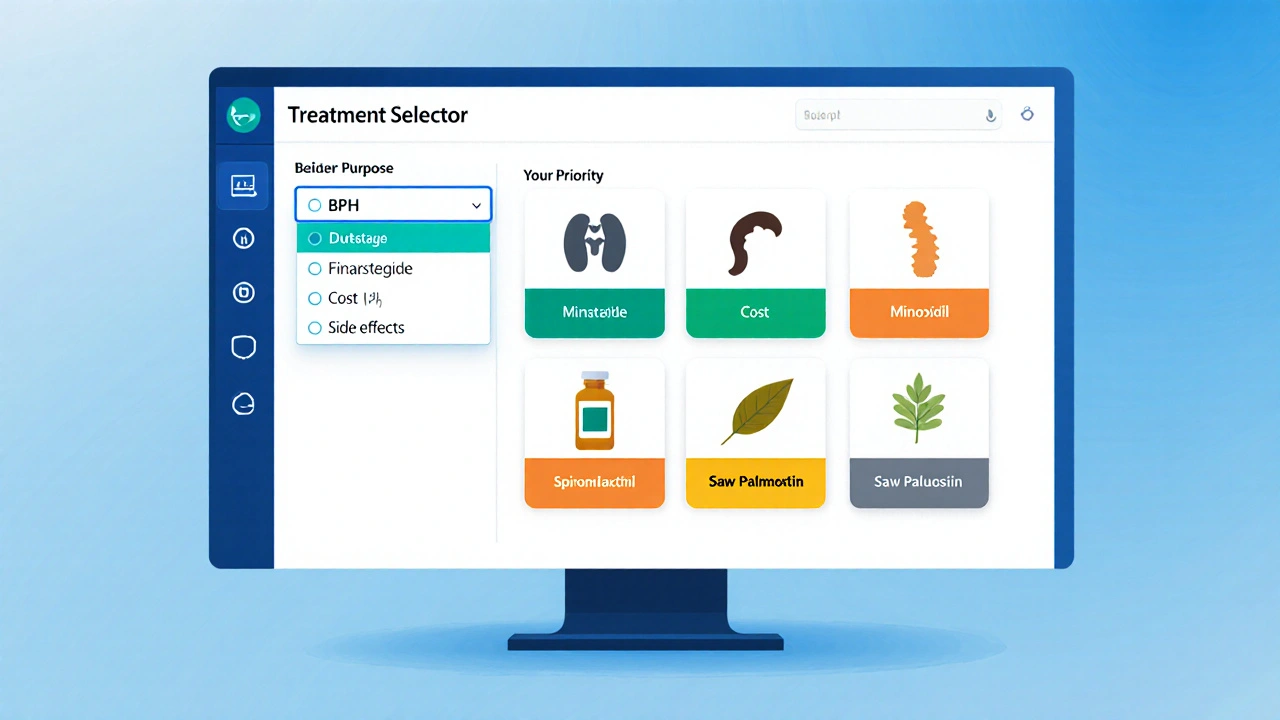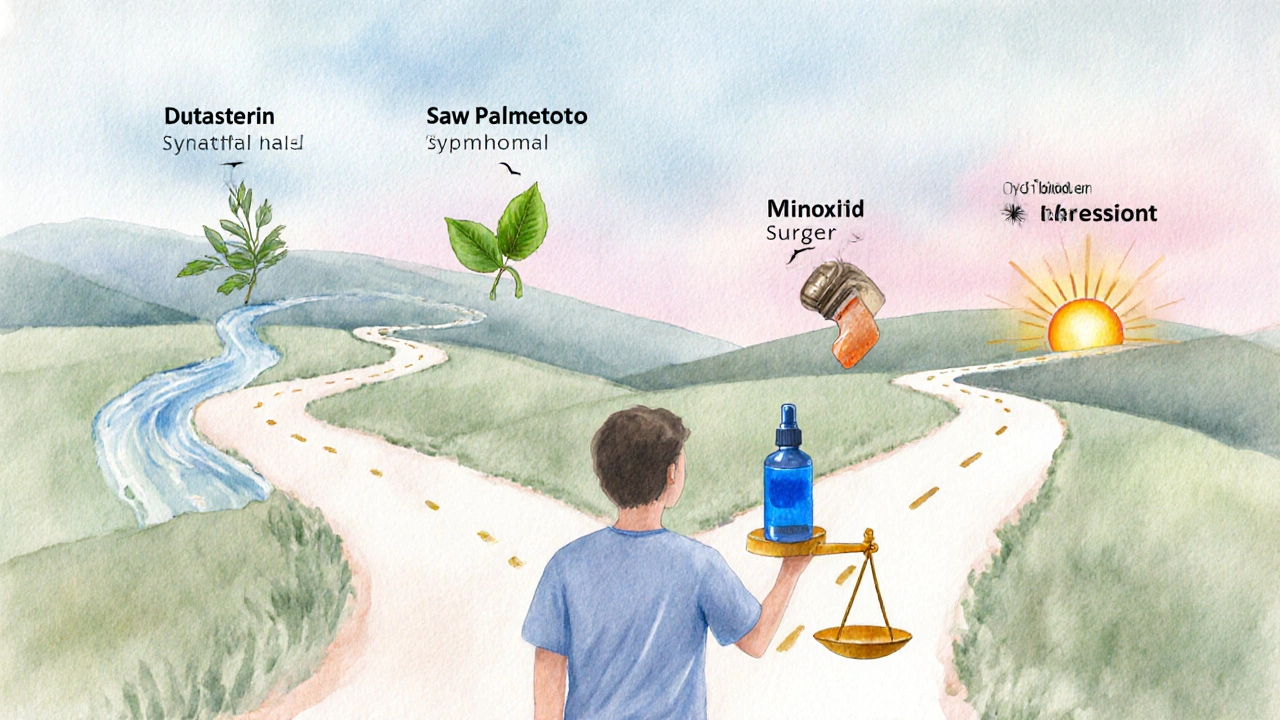Dutasteride vs Alternatives: Full Comparison Guide
 Oct, 1 2025
Oct, 1 2025
Dutasteride vs Alternatives: Treatment Selector
Select your treatment purpose and priority to get personalized recommendations.
Dutasteride
Uses: BPH, Off-label hair loss
Effectiveness: Maximum prostate shrinkage
Side Effects: Sexual dysfunction ~5-6%
Cost: £5-10 (NHS), £20-30 (private)
Finasteride
Uses: BPH, Hair loss
Effectiveness: Good prostate shrinkage
Side Effects: Sexual dysfunction ~3-4%
Cost: £3-7 (NHS), £15-25 (private)
Minoxidil
Uses: Hair loss (topical)
Effectiveness: Hair regrowth
Side Effects: None
Cost: £12-20/month (OTC)
Spironolactone
Uses: Female hair loss, BP
Effectiveness: Hormonal approach
Side Effects: Electrolyte imbalance
Cost: £2-5 (NHS), £10-15 (private)
Saw Palmetto
Uses: Natural BPH, hair loss
Effectiveness: Mild DHT reduction
Side Effects: Minimal
Cost: £8-12/month (OTC)
Tamsulosin
Uses: Symptom relief
Effectiveness: Urinary flow
Side Effects: Dizziness, ejaculatory issues
Cost: £3-7 (NHS), £15-25 (private)
Did you know that more than 10% of men over 50 in the UK are prescribed a 5‑alpha‑reductase inhibitor for prostate issues? Dutasteride comparison matters because the choice between dutasteride and its rivals can affect everything from urinary symptoms to hair confidence.
TL;DR
- Dutasteride blocks both TypeI and II 5‑alpha‑reductase - strongest BPH shrinker on the market.
- Finasteride is cheaper, approved for hair loss, but blocks only TypeII.
- Minoxidil works via blood‑flow, good for early‑stage thinning, no hormonal effects.
- Spironolactone is a potassium‑sparing diuretic with anti‑androgen action - useful for women.
- SawPalmetto offers mild relief but lacks strong clinical proof.
Understanding Dutasteride
Dutasteride is a dual‑type 5‑alpha‑reductase inhibitor approved for benign prostatic hyperplasia (BPH) and often used off‑label for male pattern hair loss. It reduces dihydrotestosterone (DHT) levels by up to 90%, leading to prostate volume shrinkage and slowed hair‑follicle miniaturisation.
Typical daily dose for BPH is 0.5mg; for hair loss doctors may prescribe the same dose, though it remains unlicensed for that use in the UK. Side effects include decreased libido, erectile dysfunction, and a small risk of breast tenderness.
Key Alternatives at a Glance
Below are the most common medicines and non‑pharmacologic options that people compare with dutasteride. Each entry includes its main purpose, how it works, and a snapshot of pros and cons.
Finasteride is a selective TypeII 5‑alpha‑reductase inhibitor approved for BPH (5mg) and male pattern hair loss (1mg).Finasteride cuts DHT by roughly 70%, making it a solid, cheaper alternative for both prostate and scalp concerns. Sexual side effects are similar but generally milder; the drug is widely covered by the NHS for BPH.
Minoxidil is a topical vasodilator originally developed for hypertension, now the only over‑the‑counter treatment proven to regrow hair.Works by prolonging the anagen phase of hair growth. No hormonal impact, so sexual side effects are absent. Effectiveness plateaus after 12months, and users must keep applying it forever.
Spironolactone is a potassium‑sparing diuretic that also blocks androgen receptors, primarily used off‑label for female pattern hair loss.Provides a hormonal route to reduce scalp DHT in women and can also lower blood pressure. Risks include electrolyte imbalance and menstrual irregularities - not a first‑line choice for men.
Saw Palmetto is a plant extract marketed as a natural BPH and hair‑loss supplement.Clinical data show modest DHT reduction (around 30%). Generally safe but not regulated; users report variable efficacy.
Tamsulosin is an alpha‑1 adrenergic blocker that relaxes prostate smooth muscle, easing urinary flow.Does not change prostate size, so it’s often combined with dutasteride or finasteride. Side effects include dizziness and ejaculatory issues.
Prostate Surgery is an invasive option like transurethral resection (TURP) for severe BPH.Provides immediate symptom relief but carries risks of bleeding, infection, and possible sexual dysfunction. Usually considered after medication failure.
Hair Transplant is a surgical method that relocates healthy follicles to thinning areas.Delivers permanent cosmetic improvement but is pricey (£4-£7k per session in the UK) and may require multiple procedures. Not a medical treatment for BPH at all.
Side‑Effect Profiles Compared
Understanding side‑effect frequency helps decide which option aligns with your health goals.
| Treatment | Common (<5%) | Less Common (1‑4%) | Rare (<1%) |
|---|---|---|---|
| Dutasteride | Decreased libido, erectile dysfunction | Breast tenderness, ejaculation volume loss | Depression, allergic rash |
| Finasteride | Sexual dysfunction | Gynecomastia, mood changes | High‑grade prostate cancer (controversial) |
| Minoxidil (topical) | Scalp irritation, itching | Dryness, unwanted facial hair | Systemic hypotension (rare) |
| Spironolactone | Hyperkalaemia, dizziness | Menstrual irregularities, breast enlargement | Renal insufficiency |
| Saw Palmetto | Stomach upset | Headache | None reported in major trials |

Effectiveness for BPH and Hair Loss
Clinical studies give us a rough hierarchy of how well each option works.
- BPH shrinkage (prostate volume reduction): Dutasteride > Finasteride > Saw Palmetto > Tamsulosin (symptom‑relief only).
- Urinary symptom relief: Combination of Dutasteride+Tamsulosin beats either alone.
- Hair‑loss regrowth (percentage of patients seeing ≥15% increase in density): Minoxidil ≈ 30%, Dutasteride ≈ 25%, Finasteride ≈ 20%, Spironolactone (women) ≈ 15%.
These numbers come from meta‑analyses published in the British Journal of Urology (2023) and the International Journal of Dermatology (2024).
Cost Considerations in the UK
Price often tips the balance, especially when NHS coverage varies.
| Treatment | Prescription Cost (NHS) | Private/OTC Cost |
|---|---|---|
| Dutasteride 0.5mg | £5 - £10 (generics) | £20 - £30 |
| Finasteride 5mg | £3 - £7 | £15 - £25 |
| Minoxidil 5% (foam) | - (OTC) | £12 - £20 per month |
| Spironolactone 25mg | £2 - £5 | £10 - £15 |
| Saw Palmetto capsules | - (OTC supplement) | £8 - £12 |
Remember that NHS funding for BPH drugs often requires a specialist prescription. Hair‑loss doses of dutasteride and finasteride usually fall outside standard NHS schemes, pushing patients to private purchase.
Choosing the Right Option - Decision Checklist
- Are you treating BPH, hair loss, or both?‑BPH favours dutasteride or finasteride; hair‑loss may start with minoxidil.
- Do you have cardiovascular or liver concerns?‑Avoid high‑dose oral antihormonal agents if you have severe liver impairment.
- Is cost a barrier?‑Finasteride and tamsulosin are typically cheaper on the NHS.
- How tolerant are you of potential sexual side effects?‑Spironolactone and SawPalmetto have different side‑effect spectra.
- Do you prefer a non‑prescription route?‑Minoxidil and SawPalmetto are OTC.
- Is a permanent solution needed?‑Hair transplant delivers lasting cosmetic results, while surgery addresses severe BPH.
Match your answers against the table below to see which treatment lands closest to your ideal profile.
| Priority | Dutasteride | Finasteride | Minoxidil | Spironolactone | Saw Palmetto |
|---|---|---|---|---|---|
| Maximum BPH shrinkage | ✔ | ✖ | ✖ | ✖ | ✖ |
| Lowest cost (NHS) | ✖ | ✔ | ✖ | ✔ | ✖ |
| OTC availability | ✖ | ✖ | ✔ | ✖ | ✔ |
| Least sexual side effects | ✖ | ✖ | ✔ | ✖ | ✔ |
| Female‑friendly | ✖ | ✖ | ✔ (limited) | ✔ | ✔ |
Common Pitfalls and How to Avoid Them
- Skipping baseline labs. DHT, liver enzymes, and PSA should be measured before starting any 5‑alpha‑reductase inhibitor.
- Stopping abruptly. Sudden withdrawal can cause a rebound increase in DHT, worsening urinary symptoms.
- Using off‑label doses without supervision. Higher doses may raise side‑effect risk without extra benefit.
- Ignoring drug interactions. Dutasteride and finasteride can amplify the effect of other anti‑androgens, leading to excessive hormone suppression.
Next Steps for Different Readers
If you’re a patient with mild BPH, book a review with your GP to discuss whether dutasteride or a cheaper finasteride‑plus‑tamsulosin combo fits your PSA trend.
If you’re looking to curb early hair thinning, start with 5% minoxidil; evaluate after 6months, then consider consulting a dermatologist about low‑dose dutasteride if results lag.
If you’re a woman with androgenic alopecia, talk to a dermatologist about spironolactone or oral minoxidil - dutasteride isn’t recommended.
If cost is the main barrier, try SawPalmetto while you await a prescription, but set realistic expectations regarding efficacy.

Frequently Asked Questions
Does dutasteride shrink the prostate faster than finasteride?
Yes. Clinical trials show dutasteride reduces prostate volume by about 20% within 6months, while finasteride averages a 12% reduction over the same period.
Can I use dutasteride for hair loss without a prescription?
In the UK, dutasteride is prescription‑only. You’ll need a doctor’s approval, even for off‑label hair‑loss use.
What is the biggest side effect difference between dutasteride and finasteride?
Dutasteride blocks both enzyme types, so DHT suppression is deeper, which can slightly increase the chance of sexual side effects (about 5‑6% vs 3‑4% with finasteride).
Is it safe to combine dutasteride with tamsulosin?
Combining them is common and considered safe; tamsulosin handles symptom relief while dutasteride reduces prostate size. Monitor blood pressure and PSA.
How long before I see results from dutasteride for hair loss?
It can take 6-12months of daily dosing to notice a visible slowdown in shedding and modest regrowth.

Jessica Wheeler
October 1, 2025 AT 12:59It is morally indefensible to ignore the sexual side‑effect statistics when prescribing dutasteride; patients deserve transparent risk communication, even if it makes the discussion uncomfortable. The physician's duty to inform definately supersedes convenience, and ignorance is not a virtue in medicine.
Mikayla Blum
October 2, 2025 AT 05:39When you think about BPH versus hair loss, it's kind of like weighing the body’s internal plumbing against its external aesthetic. Both are just manifestations of how hormones shape our daily lives, and sometimes the simplest answer is to look at what matters most to you right now.
Jo D
October 2, 2025 AT 22:19Oh great, another “ultimate guide” that pretends to be a Swiss‑army‑knife of urology and trichology. Spoiler: none of these pills are magic bullets, they’re just DHT‑modulators with a side‑effect profile that reads like a cautionary tale for the thrill‑seeking pharmacophile.
Sinead McArdle
October 3, 2025 AT 14:59I appreciate the thorough breakdown of each option; the tables make it easier to compare cost versus efficacy without getting lost in medical jargon.
Katherine Krucker Merkle
October 4, 2025 AT 07:39This is a solid lay‑person summary. If you're on a budget, finasteride looks like the sweet spot, but for maximal prostate shrinkage dutasteride still holds the crown, albeit at a higher price tag.
Taylor Yokum
October 5, 2025 AT 00:19Dutasteride is a powerhouse when it comes to shrinking an enlarged prostate, and that’s why many urologists put it at the top of their formulary.
It blocks both type I and type II 5‑alpha‑reductase enzymes, cutting DHT levels by up to ninety percent.
That deep suppression translates into measurable volume reduction in as little as six months for most patients.
However, the flip side is a slightly higher chance of sexual side effects compared with finasteride, hovering around five to six percent in the literature.
If you’re comfortable with that risk and your primary goal is prostate size, dutasteride is hard to beat.
On the other hand, for men whose main complaint is hair thinning, finasteride often provides a good balance of cost and efficacy, especially since it’s covered by the NHS for BPH.
Minoxidil, being an over‑the‑counter topical, offers a side‑effect‑free alternative for early‑stage hair loss, but you have to keep applying it forever to maintain any gains.
Spironolactone is worth mentioning for women because it tackles androgenic alopecia without the male‑specific hormonal drama.
Saw palmetto, while popular in the supplement aisle, generally delivers only a mild DHT drop, so set realistic expectations if you decide to try it.
Tamsulosin works by relaxing the smooth muscle of the prostate and bladder neck, giving quick symptom relief, but it doesn’t actually shrink the gland.
In practice, many doctors pair a 5‑alpha‑reductase inhibitor with an alpha‑blocker like tamsulosin to get both immediate relief and long‑term shrinkage.
Cost is a real driver for many patients; dutasteride averages ten pounds on the NHS, while finasteride can be as low as three to five pounds.
If you’re paying out‑of‑pocket, the private price jump for dutasteride can be steep, so weigh that against the marginal benefit in your specific case.
Don’t forget to get baseline labs – PSA, liver enzymes, and DHT if you can – before starting any of these agents.
Monitoring every six to twelve months helps catch any unexpected changes early and lets you adjust the regimen as needed.
Bottom line: match the drug to your primary priority – size reduction, cost, side‑effect tolerance, or convenience – and you’ll avoid a lot of frustration down the road.
Amy Martinez
October 5, 2025 AT 16:59Finding the right balance can feel overwhelming, but remember you’re not alone – many have walked this path and discovered a regimen that eases both the bladder and the confidence.
Josh Grabenstein
October 6, 2025 AT 09:39Sure you think the guide is neutral but pharma pushes these stats like it’s a free market. Look at the funding sources – all the big pharma money ends up here 🤔
Marilyn Decalo
October 7, 2025 AT 02:19Honestly, if you keep reading these tired comparisons you’ll never make a decision. The real secret is that most patients don’t need a pill at all; lifestyle changes and pelvic floor exercises cut symptoms dramatically.
Mary Louise Leonardo
October 7, 2025 AT 18:59That's a classic myth spread by the “no‑pill” crowd. Without proper hormone suppression you’re basically letting DHT run wild, and that's why the industry keeps pushing the drugs.
Alex Bennett
October 8, 2025 AT 11:39Everyone brings a different set of priorities to the table, so it's useful to map those priorities against the efficacy‑cost‑side‑effect matrix. If your main goal is to shrink the prostate quickly, dutasteride is the logical choice; if you’re budget‑conscious, finasteride serves you well. Keep a symptom diary and discuss the trends with your urologist – data‑driven decisions tend to stick.
Mica Massenburg
October 9, 2025 AT 04:19Sure, but doctors love their own meds. Ask them why they don’t just recommend surgery first.
Sarah Brown
October 9, 2025 AT 20:59Stop listening to the whisper campaign that cheaper is always better. You deserve a treatment that matches your clinical picture, not just your wallet. If sexual side effects are a deal‑breaker, consider minoxidil or even a surgical option for BPH.
Nick Rogers
October 10, 2025 AT 13:39Great summary, concise, helpful, and spot‑on.
Gabrielle Vézina
October 11, 2025 AT 06:19Enough with the moralising, facts speak louder.
carl wadsworth
October 11, 2025 AT 22:59Let’s keep the conversation productive; each of these therapies has a place, and the best choice often comes from a shared decision‑making process between patient and clinician.
Neeraj Agarwal
October 12, 2025 AT 15:39The guide is well‑structured, however the phrase “both TypeI and II” should have a space between “Type” and “I”. Also, “least sexual side effects” would read better as “fewest sexual side effects”.